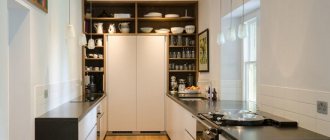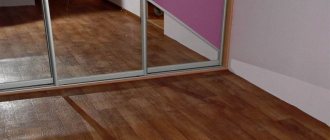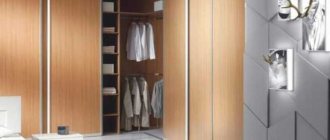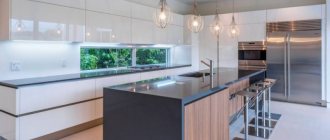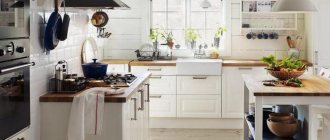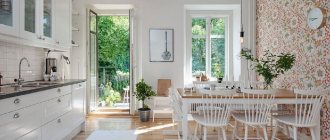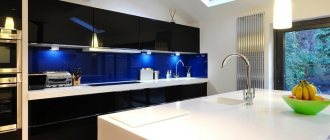The kitchen is the very place where modern men and women spend a lot of free time. Some people cook dinner every day for the whole family, others are used to getting together with friends in a pleasant environment. One way or another, the kitchen simply must be comfortable. Here are some simple tips to improve your space.
6 tips on how to make your kitchen comfortable.
Some people return to the kitchen every time because of dire necessity, but there are also many who really love being in the kitchen space. How are these two categories different? The former buy the kitchen “as is”, the latter plan the kitchen space and know exactly how to make the kitchen comfortable.
1. Size matters.
The modern furniture industry allows you to “customize” headsets to the anthropometric parameters of the person who plans to spend more time in the kitchen space. Convenience in the kitchen is determined by how comfortable for a person the numerous shelves, cabinets and other “storage departments” of important utensils are located.
Most headsets “by default” are produced in standard sizes; household appliances, such as a dishwasher and washing machine, correspond to the same parameters.
In turn, each person is individual. It is unlikely that even half of the world's population meets these average standards. Therefore, experts recommend spending a little more money and ordering a headset that is ideally adjusted to the height of its future owner. Otherwise, along with the discomfort, very serious diseases of the musculoskeletal system will come. If a tall person is constantly in a bent position, for example.
2. Use smart closets.
All tips for choosing a kitchen come down to one simple rule - it should be as ergonomic as possible
. Those who have not updated their kitchen set for a long time often still think in outdated stereotypes. In their minds, the kitchen is a set of traditional hinged cabinets. However, the furniture industry is developing much faster than many could imagine.
In modern headsets, literally every little detail is carefully thought out. Convenient cabinets for storing spices, hanging trays, a special place for storing bottled liquids. Some design solutions even require a completely open space - everything you need will always be freely accessible and in sight.
Pay attention to the return mechanisms in the design of the set, this will extend the life of the furniture.
3. Optimize corner space. How to make your kitchen comfortable and functional?
First of all, it is important to work out the functionality of almost every centimeter of space. Often a corner in a kitchen unit becomes a very difficult to reach place. However, modern engineering research effectively solves this problem.
Before choosing a headset, learn more about what retractable baskets or twin-corners, carousel-type rotating mechanisms are
- the use of such fittings in the kitchen space will allow you to store more useful things even in those corners of the set that at first glance may seem very difficult to reach.
4. Rational use of the kitchen.
If the main requirement for a future headset is functionality, you should pay attention to the introduction of a “
push - to - open ”
. It often happens that both hands are busy with a heavy saucepan or other important burden, in order to save yourself from performing unnecessary acrobatic sketches, you can adjust the furniture fittings so that the door opens by pressing your foot or... head - why not?
In addition, the “
push - to - open ” system will allow you to get rid of cabinet handles on the exterior of the doors, which will certainly appeal to connoisseurs of functional minimalism.
5. Convenient kitchen layout - comfort for the owner, durability for the set.
Modern headsets are equipped with special dampers - “closers”, which automatically ensure smooth closing of the door.
The uniqueness of this system is that it can be retrofitted to an already finished kitchen or implemented at the stage of creating a custom-made kitchen. An excellent solution for those who are used to taking care of things in their home.
6. Plan the location of your equipment wisely.
Some universal tips on the location of functional areas:
- Hob
- at least 10 cm from the cabinet, at least 5 cm from the back wall of the set;
Hood over the stove
— the width should correspond to the dimensions of the hob, the depth is not so important here. The volume of the hood must correspond to the dimensions of the room;
The dishwasher and sink are most conveniently located on the same line
, for ease of downloading. The distance between two functional zones is at least 5 cm.
Summer! Ahead are kilograms of fresh seasonal fruits and vegetables, liters of smoothies, lemonades, twists, jam, culinary experiments, achievements and victories. Time to look around, put things in order and make the busiest place in the house as comfortable as possible. Our advice will come to your aid.
How to determine the main functionality?
First, ask yourself questions: why do you need a kitchen? Do you cook often? Do two people cook at the same time (be it a husband, mother, beloved mother-in-law)? Do you receive guests in the kitchen? Think about it, how often do you, for example, use all four burners? If you have a small family or are on a diet and don't host dinner parties, you can replace the usual wide cooktop with a compact two-burner option, which will increase the work surface and make cooking easier.
If you use the oven exclusively for storing pans and pots, you should obviously give it up in favor of a washing machine (at the same time, this will help relieve space in the bathroom). Or maybe you've been dreaming of a dishwasher for a long time, and now you've found the place! For culinary inspiration, you can use a slow cooker or an air fryer - the dishes in them are no less tasty, and the space and time savings are significant. In general, it is always better to choose the content based on the habits and needs of the family.
Dinner table
A dining table in the kitchen with an island is sometimes an unaffordable luxury even in spacious rooms. But this does not mean that you need to abandon one of them in favor of the other. It is better to combine the island with the table - for example, they can have a common countertop that will accommodate the work and dining areas without losing valuable kitchen space.
Photo: contemporist.com
Finishing materials
Any surface in the kitchen should be moisture resistant and easy to clean. Artificial stone is best for the countertop, moisture-resistant plaster for the walls, and tiles or glass for the kitchen backsplash. Many people are afraid of wooden floors - and in vain! Dishes dropped on a wooden floor will most likely not break, and thanks to modern wood processing methods, it is easy to clean. To decorate the ceiling in the kitchen, it is better not to use suspended structures; they reduce the height of the room. A stretch fabric is ideal in this case.
What is worth investing in?
It is important that we provide good lighting in the kitchen - not only basic lighting, but also task lighting that illuminates the countertops. Practical furniture that covers the entire surface of the wall will also be of very high quality. This helps make the most of the available space.
Finishing materials in the kitchen must be abrasive, resistant to permanent stains and not subject to mechanical damage. Remember that a good work surface should be made of heat-resistant and non-absorbent material.
Work triangle
The preparation of any dish has an algorithm. Usually we take the ingredients out of the refrigerator, wash and separate them in the sink and then cook on the stove/oven. This is why the work triangle is the refrigerator, sink and stove. The three main elements of the kitchen form the vertices of the triangle, and its sides form the route of the hostess. The length of the sides of the triangle depends on the area of the kitchen and can range from 1 to 2.5 m. The closer these items are located, the more convenient it is to cook, which means less time has to be spent on unnecessary movements.
Types of kitchen design
The ideal option would be the one where the space remains as free as possible. This will allow you to move around the kitchen freely, creating a feeling of spaciousness. Popular designs are presented in the table.
| Design | Description |
| Single row kitchen | An excellent solution for small spaces. The work area is located on one side, the second is used for eating. |
| Double row | To save more work space, place the stove and sink on one side, and place the refrigerator opposite. |
| L-shaped | Allows you to adjust the distance between surfaces. Therefore, the design is suitable for any room size. |
| U-shaped | Work surfaces are placed along three walls. Therefore, it is worth using a similar option in large spaces. It is important to comply with all parameters. The length of the rear wall must be at least 2.5 meters. |
| Peninsular | It is possible to separate the kitchen from the dining room. You can use a stove or a cabinet with a sink. |
| Ostrovnaya | Suitable for large rooms only. Consists of using a complement in the center. The basis is an L- or U-shaped version. |
There should be no unnecessary items in the kitchen
Finding the right design for your kitchen is not difficult.
Horizontal zoning
To ensure that the necessary products are always at hand, and that working in the kitchen is a pleasure, you need to fill the cabinets, taking into account the rule of horizontal zoning. It is better to place the heaviest objects and dishes at the bottom, while it is more convenient to fill the lower tier with drawers. Then there will be no dark shelves and corners littered with junk, all items will be in direct access. The middle level usually houses the most popular items in kitchen life, appliances and tableware. And out of old habit, you shouldn’t put supplies of cereals and sweets upstairs. You will forget about them anyway, unless you specifically hide chocolate bars for a sad day.
Kitchen in the shape of the letter U
The most convenient layout for placing furniture in the kitchen. An important condition is the territory for passage, at least one meter.
The furniture will be placed most successfully if you make a built-in window sill in the kitchen.
Avoid dangerous proximity between household appliances
When distributing household appliances and appliances in the kitchen, you need to take into account the location of the riser and do not forget about the basic rules of neighborhood. It is important to leave a safe distance between devices, which can be found in the operating instructions. Violation of these rules threatens not only equipment breakdown, but also accidents. Without proper insulation, a refrigerator will not live a long life next to an oven or cooktop. They should be separated by at least 15 cm. Any equipment near a gas stove is a time bomb. For the stove, you need to set aside a separate area at a safe distance from other appliances and flammable objects (curtains, towels). The optimal distance of the hood from the hob is 70–80 cm.
Keep the refrigerator away from all heating and heating appliances (oven, microwave, gas water heater, stove, radiator). Leave at least 5–10 cm between the wall and the refrigerator. Place the TV away from the “hot” and “wet” zones.
Multi-level blending
The dining table in the kitchen does not have to stand alone. It can be combined with a work area on the kitchen island, but at different levels. This is a practical solution from both an ergonomic point of view and an aesthetic one - while eating, the work surface will not be in the field of view, more space will be saved for movement, and the simple interior will only benefit from such an interesting design.
Photo: decoratorist.com
Pair storage
Remember a simple principle: things that are used together should be stored together. This is very practical advice.
- Sink area: Keep dishwashing liquid, sponges and colander here.
- Cutting table: This should include knives, a cutting board, several bowls for mixing food, vegetable oils for cold dishes, vinegar and lemon juice, salt and pepper.
- Stovetop: Keep frying oil, spices used during cooking, and a net to prevent oil splashes nearby. It’s convenient if the cabinet with pans and pots is also nearby.
- Baking: sieve, measuring cup, molds, special paper, scales, mixer are best stored in close proximity to each other.
- It is also better not to put tea, coffee, coffee grinder, Turk and sugar in different cabinets.
- It is convenient to group food supplies by category: cereals, canned food, seasonings.
Identify and reorganize places that attract clutter
One of the famous kitchen Bermuda triangles is the space under the kitchen sink. The key to organizing it is to pay attention to what accumulates there. Sponges for washing dishes, rags, cleaning products - all this can be stored directly on the pipe using plastic hanging structures. Make this space more functional. But remember, the place is quite easily accessible, so do not place substances there that are toxic or dangerous to children and pets, or place these products in a container or box with a lock.
Ergonomics and individual needs
Despite the fact that furniture designs have their own standard parameters, when choosing custom-made furniture we can manipulate their sizes.
For people with short stature, instead of the standard top height of 85 cm, it is worth going down to a height of, for example, 75-78 cm, while for tall people a height of about 90 cm will be more useful. Adapting the kitchen to your physical predispositions will undoubtedly prove the most functional solution.
Sometimes in our apartments there are things that are not necessary to use, but we don’t want to get rid of them yet, what should we do in this case?
In this case, Safebox warehouses recommend using the modern service of temporary storage of items in special boxes of various sizes per m2.
Space for notes
It is very practical to have a place in the kitchen for notes. This could be a magnetic notepad where you can keep a shopping list. Each family member can always add the necessary product at any time. Thanks to such a list, it is easier to track and maintain the quantity of all stocks. You will always see what you really need to buy at the moment, avoiding random costs. Cookbooks that you often use when cooking are also useful in the kitchen; you can organize them on a narrow shelf on the wall. You don’t have to constantly run to another room and search. A magnetic board for exchanging information with family or creating a weekly menu can work as a decorative element and a children's corner.
A beautiful modern kitchen is a functional concept that takes into account the volume of space and optimally combines work processes and aesthetics. Let's look at specific tips that will allow you to rationally equip even the smallest kitchens. This means that there will be more space in your kitchen.
Equipment of kitchen cabinets in the preparation area
We wrote earlier that for convenience, all the necessary kitchen utensils should be at hand! Dishes and cutlery should be stored directly in the cooking area, that is, near the stove, and baking supplies should be stored near the oven. And it’s easier to keep order in the kitchen not in cabinets, but in drawers. Which should have a full extension mechanism so that you can get the necessary item at any time. In the drawer under or next to the hob, it is convenient to store ladles and ladle, and in the lower ones - pots, pans and lids. For baking accessories, narrow pull-out cabinets 150-200mm wide are provided, where everything you need will be placed: baking trays and molds can be placed vertically, and rolling pins and baking paper can be stored on the top shelf. And be sure to plan drawers for spices, bottles and cutting boards. Equipment for a compact kitchen An important point in designing any kitchen is to place the necessary equipment and the kitchen appliances desired by customers.
In small spaces, the implementation of this task borders on fantasy. We recommend, and the pros make the most of built-in appliances, which have many advantages and allow you to find optimal solutions for using the kitchen space.
— The customers of this project are a middle-aged couple with a child. The owners lead an active lifestyle, often receive guests and cook a lot at home. Hence the main wish of the customers when designing the kitchen and living room - they wanted to make the kitchen-dining and living room areas a single space, but at the same time they wanted to make the kitchen work area as inconspicuous as possible. As a result, we designed the kitchen in such a way that it was located in the back of the room, around the corner. With this arrangement, the process of cooking and cleaning after cooking is as hidden from view as possible, since the hob, sink and dishwasher are located just in the back of the kitchen around the corner. www.goldensilk.ru
Alexander Krivov, interior designer
— In the kitchen I wanted to place as many appliances as possible without cluttering the work surface. As a result, the choice fell on built-in compact equipment. In particular, we installed built-in Electrolux appliances: a microwave oven with grill function; an exclusive oven. The uniqueness of this oven is in the functions of cooking with steam and at low temperature in a Sous Vide vacuum. This device will also replace a steamer, since there is a 100% steam mode, in addition to other modes with steam. And a huge number of automatic recipes will give our customers ideas for dishes and select cooking parameters. And thus, with the help of these two devices, owners will be able to cook in almost any possible way.
Alexander Krivov, interior designer - And also: a built-in coffee machine with a full cycle of preparing perfect coffee; a compact wine cabinet - the best in its class in terms of energy consumption; a built-in TV for the kitchen with a stainless steel frame and the ability to rotate the screen, which is especially convenient in compact layouts.
— In addition to the full range of Electrolux compact series of built-in kitchen appliances, it is also attractive that all appliances are the same size, which allows them to be placed together in a row, in a column, or in a group of four - this is both convenient and looks very harmonious.
Unique design
Evgenia Krivorog, architect
— Follow a few tips for arranging a small kitchen: Don’t be afraid to make contrasting colors. For example, the kitchen facades are dark - the floor covering is light. It is a big misconception to do everything in light colors. I advise you not to use “all shades of beige” in the interior of small kitchens. It is next to dark shades that light shades look brighter, as they reflect light, especially glossy surfaces such as tiles or marble on the floor. Consider also cool shades, such as light blue or dusty pink, for example, when using wall colors. www.evgeniyakrivorog.com
Evgenia Krivorog, architect
— The ceilings should not be made at different levels; it is enough to decorate them with ceiling cornice. It is better to place the stove and oven as far away from the passage as possible and, of course, to place it at a distance from the sink. The kitchen work area should be as functional as possible.
Therefore, it is necessary to make an effort to place everything conveniently, and especially think through the location of areas with household appliances www.evgeniyakrivorog.com
Finishing the facades of a kitchen unit is an element of kitchen design that will emphasize the individuality of your interior and make it possible to choose a winning combination of colors and materials. A modern kitchen is not only a monochrome glossy one, and a classic one is not necessarily a brown wooden concept. There are a huge number of unique solutions for each room.
— The main wishes of the customer were to create a cozy space for a family of 2 adults and 2 small children during their stay at the resort. Warm shades of walls and furniture, wooden beams on the ceiling, floral patterns, and a large amount of wool textiles were agreed upon immediately. It is a very rare case when the project was fully agreed upon the first time and no serious problems arose during the implementation of the project that required adjustments to the project. shipkova.com
Olga Shipkova, interior designer
— The kitchen set and table were custom-made by the ArtInterior studio. Facades - painted MDF with patination; wood-look countertop and apron. Belgian chairs J-line series. Textiles, wallpaper, stucco elements - Empire Decor company. A special wish was to equip the premises with equipment that would allow you to prepare delicious and light dishes without hassle. The choice was made in favor of the customers' favorite brand, Electrolux.
— In this small apartment in Moscow, it was necessary to create a cozy interior in light classics with notes of American aesthetics for a married couple without children. When arranging a kitchen, attention to detail, thoughtful functionality of the kitchen, and, of course, visual effects of interior design are very important. In the overall color scheme we settled on a combination of dark chocolate, vanilla, baked milk and warm gray, but in the kitchen I suggested adding the color of sage leaves - not bright and in the context of the main shades of the apartment, this color brings freshness and seems to me to visually expand the small kitchen. bogacheva-interiors.ru
Anna Bogacheva, interior designer
— Kitchen set Donato furniture factory Stylish kitchens are embodied in a neutral gray color. Lately, I have been offering customers to combine furniture of different price categories, but I never advise saving on the basic components - flooring, paint, textiles, in my opinion, what makes the interior whole and “correct”.
I must say the kitchen is only about 7 square meters. and therefore there were many tasks, in addition to being functional, it was necessary to visually expand the kitchen - for this I used mirrors and an advantageous color combination, light curtains, open shelves, an “airy” lamp. An important component of the convenience of the kitchen is lighting: work areas, general lighting around the perimeter and lighting for the mood: sconces, lighting or a beautiful lamp above the dining table.
Kitchen lighting
The kitchen work surface should always be illuminated. The current standard for quality is LED lighting, which provides a good flow of light while being more durable than traditional lighting systems. The best illumination is provided by those lamps that have a high color temperature. The best solution is a temperature of 5000 Kelvin, 24 LEDs per 1 meter of strip. Work area lamps should have an inconspicuous appearance, while pendant lamps can be interesting accents.
— Before starting renovations, it is important to provide good lighting in the kitchen. In vain, some people think that one light source is enough for a small room. At the project stage, it is planned to illuminate the work area, the eating area and turn them on separately to create a different mood in such an important room of the house. avetiska.wixsite.com/decor
Marina Sargsyan, interior designer
— This kitchen was designed for a small one-room apartment, one of those in old houses, with complex geometry, with protrusions, ventilation ducts... In such a kitchen it can be very difficult to place all the necessary equipment. The presence of compact built-in equipment helps. It can be placed in a tall cabinet one above the other, for example, a built-in small refrigerator and an oven, and it is convenient to integrate a compact coffee machine and microwave into wall cabinets, thereby freeing up space for the work surface.
Marina Sargsyan, interior designer
— For small spaces, I mainly use a two-burner hob. An induction hob is installed directly in this kitchen. And I install a small dishwasher, for 6 sets of dishes; it takes up little space, having dimensions of 55x44 cm, and is hidden behind the kitchen facade.
The placement of a dining area in a small kitchen should also be thought out in advance. There are many options for placing a table and chairs. This is the format of a bar counter, which the designer used so successfully, playing with the existing geometry of the room. Or a small coffee table and chairs with a lightweight design or light colors so as not to burden the space. Architects and designers revealed the secrets of their craft, and using the examples of the projects provided, we were convinced that there are many interesting solutions for a small kitchen - modern design trends and developments of kitchen appliance manufacturers embody the desire to combine functionality, aesthetics, and a sense of free space.
: bedrooms, living rooms, children's rooms, hallways and more.
The article provides the basic rules for - they are generalized and therefore apply to all types of kitchens. One of the main requirements for kitchen design is functionality and convenience. After all, cooking here is convenient, and dining is pleasant if the design is thought out for a specific room and for the required needs.
How to make a kitchen yourself: a practical review
Hello dear friends.
It’s no secret that the most difficult and expensive piece of furniture to make (if you don’t take the production of retail displays) is a kitchen set, and, by and large, learning how to make cabinet furniture means learning how to make kitchens.
It is this moment, by and large, that is most interesting to novice furniture makers.
In this article, I will try to talk about this, and briefly describe the entire process from design to installation.
So, from the very beginning, you need to study the room where you plan to manufacture the kitchen set, and decide (in general terms) what kind of set (in this particular room) it makes sense to manufacture. For example, if the room is not large, then most likely you need to make a straight kitchen into it, which takes up the least amount of free space.
If the room is large, then the kitchen can be made into a corner, U-shaped, island, or whatever you like. Plus, in a large kitchen there is an opportunity to “expand your design ideas”!
But design is a separate topic, we will not touch on it, but will move on.
When the configuration of the future product has been determined (taking into account all the nuances of the room), you can proceed to measuring the room.
I won’t write much about the measurement; you can read about this topic here, but you can read about how to correctly design it graphically here.
Here, during the measurements, you can already “sketch” a sketch of the future kitchen, and decide based on the overall dimensions (roughly) that this particular kitchen (which is in the sketch) will fit this room.
This is where the organizational issues end. It's time for design.
Measuring the premises and creating a project are the most crucial moments in the entire process, therefore, they need to be taken very seriously, without haste, with double-checking.
How is the project done?
First, the gaps are given for the lower and upper kitchen bases, after which the overall dimensions are divided into parts (under modules), the alignment of the modules is calculated (for example, the lower module for the hob and the upper module for the hood), the position of all built-in appliances is distributed, in a word , the overall dimensions are divided into the dimensions of individual modules.
After this, each module is calculated in detail.
It is better to do this work in a program (PRO-100, for example).
By making a project in such a program, you are insured against mistakes, and when the project is ready, you receive all the details at once. Moreover, you can always look at the project in the correct proportions, which is very important when creating a design.
After this, you need to make a cutting map (in Cutting-2, for example), mark on it the gluing of parts with an edge, the processing of figured parts (if any), write a list of accessories and fasteners, and, in general, that’s all, you can buy materials, order their processing (cutting, gluing, etc.).
When the “cutting” is ready (all the necessary accessories have been purchased), it needs to be delivered to the assembly site (the assembly site for the kitchen set can be a garage, a barn, or it can even be assembled in an apartment).
If possible, at the assembly site, you need to install the necessary equipment and fittings, for example, embed the hood into the box (if it is mortise), embed lamps, etc. This will save time on the upcoming installation.
You also need to remember to dock (under intersectional ties) all adjacent modules with each other.
When all the modules are assembled, the facades are hung, in a word, when everything is ready, the kitchen is taken out for installation.
During installation, the lower base is installed first, then the upper one.
If the kitchen is corner, installation always starts from the corner.
So, having aligned the lower base (fastening all the modules to each other with coupling bolts, and leveling the whole “this thing” (with the help of adjustable supports), a tabletop is installed on it, which, in turn, is marked for insertion of the sink and hob .
The sink is cut into the countertop immediately, after which the countertop is attached to the lower base (the hob and oven can be installed at the very end of the installation).
If the set being installed is corner or U-shaped, then the lower base is installed completely, with all the corner elements, after which the countertops are installed.
But, in this version, two corner elements of the bottom were installed after the main base was installed and the tabletop was fixed to it. But, it is better for beginners not to do this, but to do as stated in the first case.
After installing the bottom, the top is hung.
An axis is marked on the wall on which the mounting plate is hung, on which, in turn, the upper modules are hung.
If pipes run along the wall, these points must be taken into account in the design, and during installation, the necessary upper boxes must be “cut” to accommodate them with a jigsaw.
The upper modules, like the lower ones, are fastened to each other with coupling bolts. The position of these modules in space is regulated by canopies (adjustable).
After all, the facades are hung on the boxes (which were removed before installation), the baseboard is placed on the countertop, and that’s it, the kitchen is installed.
A more detailed description of each aspect of the design, assembly and installation of a kitchen set can be found in the articles on this blog.
And this is where I will end, until we meet again!
Video on the topic “Quality Formula”: Choosing a sink for the kitchen
To understand the essence of the concept of “comfortable kitchen,” you need to understand that the kitchen, being a single room, consists of separate functional areas. Each zone performs a corresponding function, but some zones are used more often, some less frequently. Based on this rule, you need to decide how the room will be used and set priorities. But how to do it right? Let's figure it out together. To avoid confusion, the action plan consists of several main points, each of which is then clarified.
How to choose kitchen furniture
When choosing furniture, you should consider the following.
- When choosing models and shades of countertops and cabinets, keep in mind that many furniture stores use special lighting. Therefore, the facades look somewhat lighter than in a normal environment. This must be taken into account if you want to choose the required tone.
- Decide on the material. The facades are made of glass, wood, MDF. There are plastic and aluminum.
- Keep in mind that wooden facades are made mainly in natural shades. It is not easy to care for the product. But such models look beautiful and are environmentally friendly.
In addition, pay attention to the quality of the product. How well do the doors open, are there any scratches or chips.
Kitchen furniture
The furniture was chosen as the first point quite rightly, if only because don’t rearrange the furniture; if it doesn’t match the size and features of the kitchen, comfort may not be achieved at all. Let's start with the headset. The set is selected, taking into account the area of the kitchen in accordance with taste, preferences, desired requirements, but the smaller the room, the narrower the choice. A corner set would be the ideal choice. There are two options: create a set yourself by choosing the appropriate modules, or order it. The first option is cheaper, and besides, many companies now make designer headsets, and the buyer himself can choose the desired configuration. The second option is more expensive, but in this case the furniture will fit into the interior as much as possible, using every useful centimeter - what is needed. In addition to the area, you need to take into account the shape of the kitchen - a corner set will fit perfectly into a square kitchen, but will create cramping in a rectangular one.
Chef and Sous Chef
All of these areas of responsibility can be defined for one position. In this case, the direct title of the kitchen manager position is not of fundamental importance (chef, sous-chef, production manager). Or you can divide it between two. In this case, the positions most often called Chef and Sous Chef. The division of areas of responsibility between the two positions occurs so that the functionality is not duplicated. That is, the Sous Chef turns from just an assistant to the Chef (as is often the case in restaurants), into a full-fledged kitchen manager, with independent functionality.
Administratively, the Sous Chef reports to the Chef. And, of course, the Chef, as the administratively main person, is ultimately responsible for everything that happens at the Production. As is the case with the Manager, who is responsible for everything that happens in the establishment. But this responsibility is precisely administrative in nature, not functional.
The division of functionality between the Sous Chef and the Head Chef depends on the specific establishment and the desire of the Manager or Owner. But there are several fundamental points:
- Chef is a position that is more related to the strategic level of management. And all strategic issues are concentrated on it. Sous chef is an operational level management position. He is primarily responsible for what happens on his shift.
- The chef can do his job whenever he wants and not necessarily directly in the restaurant. And the Sous Chef, while managing the shift, must stay on schedule and can only work in the kitchen. This is due to the level of management itself.
As mentioned above, it is up to you to decide how to distribute responsibility between them. We can only give an example of the distribution of responsibility, as we see it:
| Chef | Sous Chef |
| · Menu offerings meet guest demand. · Changes to the technical specifications for the kitchen are made in a timely manner · Timely informing management about the need to order equipment and inventory · Consumption of 100% of kitchen products is included in the automation system | · All food storage areas in the kitchen are organized in compliance with storage rules. · No fines from government agencies for non-compliance with sanitary and safety standards in the kitchen · Chefs are provided with all the necessary resources to prepare dishes in accordance with the Labor Code 100% · The quality of accepted kitchen products according to organoleptic characteristics corresponds to the standard. · Every chef knows how to prepare dishes 100% according to the technical specifications · Lack of a stop list in the kitchen · The number of cooks on shift is necessary and sufficient for the smooth operation of the kitchen |
For each of the above areas of responsibility, there is a whole set of functional responsibilities. That is, a set of steps that allow you to fulfill one of the areas of responsibility.
Video on the topic “Functional kitchen with Fiera”
Kitchen table. From the very beginning, you need to decide whether a dining table is needed in the kitchen at all - in a small kitchen this is especially important. Whether the family dines in the kitchen or in another room, whether the family is large - questions, answering which, you can make the right choice. If the size of the kitchen allows, it is quite possible to install a full-size rectangular table, at which a large family will be comfortable. If the kitchen is smaller, it is better to choose a round table so that the corners do not interfere. If the family consists of two or three people, and the kitchen is very small, you can use a folding tabletop or a transformable table for a family meal.
The remaining parts of the furniture - hanging drawers, bar counters - are installed at the request of the owner, taking into account the area of the room and the location of the rest of the furniture. The increasingly popular island design is good for a larger-than-average kitchen, but it has its advantages, which will be discussed below. The selected furniture must be positioned correctly. That's right - this is so that everything is at hand and nothing interferes with movement around the kitchen. Here we need to say something about the functional areas that were mentioned at the very beginning. The three most used of them - the stove, sink and refrigerator - should ideally be spaced at equal distances from each other.
History of cuisine in names
In just a century and a half, the kitchen has come a long way from a utility room to the most high-tech, and often the most beautiful room in the house. Katharina Beecher, Christine Frederic, Lilian Gilbert and Margareta Schute-Lichotsky have contributed as much to the kitchen as any manufacturer of modern kitchen units.
The history of old-style cuisine is a history of oppression. The housewives cared little about rationalizing their work: the stove in one corner, the table in another, shelves with pots in a third, the sink in a fourth... During the cooking process, women rushed around the entire room, literally covering kilometers. The idea that something needs to be changed in the environment itself was the first to come to the mind of Catharine Beecher, the sister of the famous writer Hariette Beecher Stowe.
Katharina Beecher described her thoughts in a book on home economics published in 1843. There she also posted a picture of the ideal so-called. “model kitchen”: a small compact room with rows of wall cabinets, where everything is at hand and easy to manage alone. The idea was copied from a steamboat galley - Miss Beecher loved steamboat trips on the Mississippi. And in 1869, the Beecher sisters published a joint book, “The House of an American Woman,” where they continued to develop the theme of rationalizing the kitchen space.
Half a century later, in 1913, the topic of rationalizing the kitchen environment was raised by Christine Frederick.
She conducts an interesting experiment - she will set up an experiment and count how many kilometers (!) the housewife runs around the kitchen per day (a thread is tied to the test subject’s leg). For the first time in the history of the kitchen, she will offer to distribute zones: cooking - washing - storage in such a way as to save movement. In 1920, Christine Frederick wrote an entire book, Household Engineering.
Around the same years, a wonderful woman, Lillian Moller Gilbreth, became involved in the topic of kitchen improvement. The inventor and founder of scientific ergonomics, she was also the mother of 12 children.
Lilian Gilbert makes a special contribution to the history of cuisine. From personal experience, sketching the movements of her entire large family around the kitchen, she tries to calculate the optimal placement of cabinets and tables in the kitchen. The result is examples of “practical kitchens” created according to the laws of ergonomics.
In 1926, all the developed ideas finally resulted in the first standard design of a functional kitchen - the so-called “Frankfurt kitchen” by architect Margarete Schütte-Lihotzky.
It was developed for standard housing developments in Frankfurt. Despite the small size of the kitchens in the 1.87x3.44 houses, all the necessary furniture and equipment - a stove, a sink, a work table, and cabinets - fit well into them.
Cabinets are divided into lower ones, standing on a common base and wall cabinets. Everything is at the same height and the same size. Very little time passed, and by the mid-30s the proposed idea of kitchen modules finally replaced free-standing cabinets and cabinets. Catalogs are filled with an abundance of different variations of kitchen sets: as a rule, all cabinets are now covered with a common countertop, wooden or tiled.
With the advent of new materials in the 1950s, kitchens became colorful. Wood is being replaced by plastic, stainless steel, and anodized aluminum. Household appliances are not far behind - from utilitarian items they become kitchen decorations.
By the 60s, the passion for kitchen appliances became widespread: the more of them, the more prestigious. In 1969, the pan-European committee introduced uniform standards for kitchen modules: the height of the cabinets, their depth, etc. Now manufacturers are starting to experiment with materials and finishes without affecting the dimensions of the cabinets.
The improvement of the kitchen hood in the 1980s makes it possible to no longer separate the kitchen into an enclosed space; a studio kitchen combined with a dining room and living room is now in use. Now and for many years to come, the kitchen is not just a room for cooking, but also an object of prestige.
The modern kitchen is still a real springboard for testing all new trends in design and technology: it is here that new materials and appliances most often appear, a new range is used, or experiments are made with style.
Video on the topic “How to make a kitchen functional”
By placing two zones on the same line, and placing the third separately, you can get the so-called kitchen triangle. Most often there is a separate sink or refrigerator. If the kitchen has an island design, the sink is built into. If a dining table is a necessity, it should not interfere with access to the main functional areas.
The height of the working surface and hanging drawers should also be chosen based on metric data, but in this case it is not the area of the kitchen that is taken into account, but the height of its owner. The tabletop should be located at waist level, and the cabinets so that you don’t need to reach for them. It’s better if the cabinet doors rise vertically, then you don’t have to worry about bumps on your head. Various devices designed to save space and provide quick access to kitchen utensils make a significant contribution to the convenience of the kitchen. The main “helpers” are railings and various suspension systems.
Little tricks in the kitchen for the convenience of wall-mounted upper cabinets
The distance between the work surface and the wall cabinets of the kitchen unit can also be “upgraded” and made more functional and convenient.
DIY lighting under the upper kitchen cabinets
Lighting a work surface with your own hands is quite simple. On sale you can find many elongated LED lamps powered by batteries. All you need is to choose the right size (for example, in Fixprice). And secure it to the bottom of the kitchen wall cabinet using double-sided tape.
Rails with hinges
The railing pipe itself, complete with holders and plugs, is not that expensive. But the attachments for it in the form of hooks, various baskets, jars for spices are quite expensive. But you can always find cheap analogues that are in no way inferior in functionality.
Functional addition for the work area
Tired of wasting energy and time scrubbing off grease and washing the baseboard and countertop every time after cooking? Place special foil in the area of the stove on the kitchen apron!
By the way, foil also saves you from washing the stove itself (hob). True, this life hack is suitable if the burners are gas. You should absolutely not use foil for electric and induction hobs.
Little tricks in the kitchen for convenience: many housewives use ordinary food foil. It turns out cheaper and no worse. It fulfills its role – protection from accidental contamination – completely.
Want to share your own life hacks that make your kitchen more convenient? Write about them in the comments! Let others know about them too.
Functional devices
Railing is a metal pipe that holds hooks and fasteners, shelves and various holders. They come in horizontal and vertical versions and are as easy as pie to install—you just need to screw two screws into the wall or ceiling. The most frequently used kitchen utensils are hung on the railing. But with all the convenience of this device, it is worth considering its location - it is better not to hang it above the stove, so that splashes of the prepared food do not stain the utensils, and mini-shelves with seasonings above the sink at least look ridiculous.
Another important detail is the trash can - it is better if it can be opened hands-free by pressing the pedal. And so that it does not get underfoot, it is placed in the corner next to the sink or in the cabinet under the sink itself, so it is better to choose this object of a rectangular shape. A kitchen, even if it is spacious, seems cramped if the design details are poorly thought out. For example, the best choice for a small kitchen would be pastel shades of facades, combined with enlivening bright tones of details - two primary colors, it is better not to use them anymore. Mirror surfaces, spot lighting of furniture does the same.
Kitchen expansion options
Small kitchens can be difficult to enlarge. But if you think through everything carefully and use a few effective techniques, you can slightly increase the free space. The options are as follows.
- Furniture. Place it linearly or L-shaped. Space is limited, so make the most of it. The window sill can become a work area. Choose sliding doors for cabinets.
- Facade. Avoid any patterns or decorative elements. Facades should be laconic and strict.
- Technique. Choose functional models that combine several functions. Discard items that are not necessary. A 4-burner hob is not required if you only use 2 CBs. The microwave can be hidden in a closet rather than placed in the work area, where it will take up extra space.
- Light and mirrors. Choose furniture pieces with a mirror design. You can place mirrors on the walls. Let there be a chandelier in the dining area. You can make spotlights in the work area.
It is better to place furniture linearly or L-shaped
It is recommended to use multifunctional equipment
Using the advice of professionals, you can enlarge the room a little
